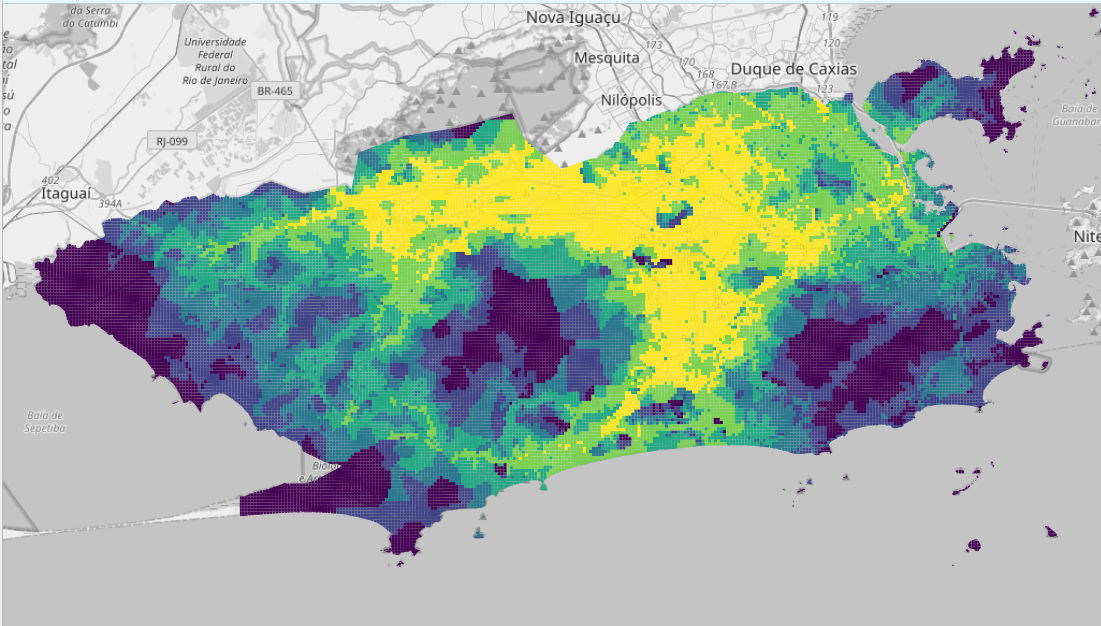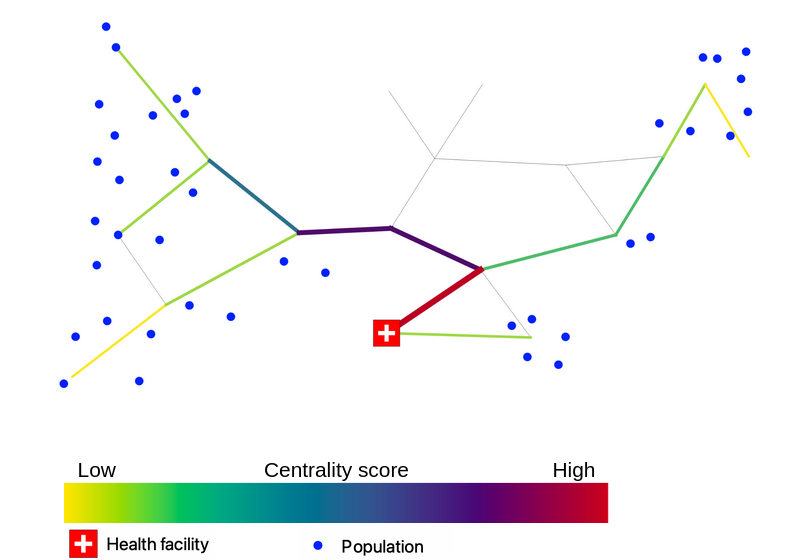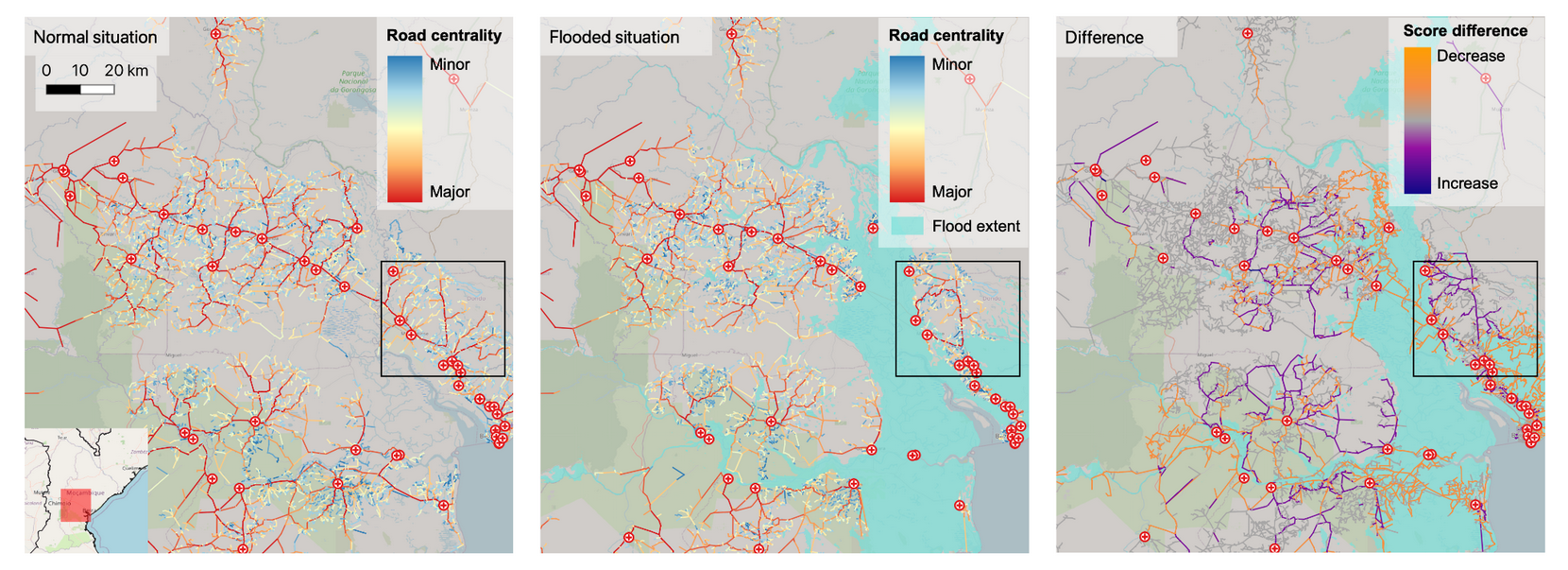Network analysis - Centrality#
In the context of road routing, network centrality refers to the assessment of the significance and influence of specific road segments or intersections within a transportation network. It helps identify key routes or nodes that play a crucial role in connecting different locations, optimizing traffic flow, and enhancing overall accessibility and efficiency of the road network. Openrouteservice supports the analysis of network centrality via an export endpoint. Users can obtain a weighted, directed graph representation of the OpenStreetMap road network. Options on the route type: fastest, shortest and routing profile are available to choose from. The exported graph can be used in other environments or tools to conduct further analysis, like centrality measures etc.
Usage in other software
QGIS
Network AnalysisR with
sfnetworksPython
NetworkX
References:
Petricola, S., Reinmuth, M., Lautenbach, S. et al. Assessing road criticality and loss of healthcare accessibility during floods: the case of Cyclone Idai, Mozambique 2019. Int J Health Geogr 21, 14 (2022). https://doi.org/10.1186/s12942-022-00315-2
Zia M, Fürle J, Ludwig C, Lautenbach S, Gumbrich S, Zipf A. SocialMedia2Traffic: Derivation of Traffic Information from Social Media Data. ISPRS International Journal of Geo-Information. 2022; 11(9):482. https://doi.org/10.3390/ijgi11090482
Klipper, I. G., Zipf, A., and Lautenbach, S.: Flood Impact Assessment on Road Network and Healthcare Access at the example of Jakarta, Indonesia, AGILE GIScience Ser., 2, 4, , 2021. https://doi.org/10.5194/agile-giss-2-4-2021
Closeness centrality#
Closeness centrality is a measure that quantifies how easily a node in a network can reach other nodes, based on the inverse of the average shortest path distance from that node to all other nodes in the network.
Determine the centrality of locations within a network based on efficient distance and time calculations for travel between different grid cell centroids in Rio.
Grid-based analysis: Employed a 200m grid overlay on the city to divide the wider area into manageable units for analyzing mobility patterns and exposure
Motorized and pedestrian routing profiles: Calculated travel distance and time for each grid cell centroid, considering both motorized travel and pedestrian routing options.
Purpose: Developed an exposure layer to understand human mobility patterns, particularly relevant for assessing the spread of vector-borne diseases like Dengue fever in Rio.
The analysis contributes to an exposure analysis by identifying individuals who may act as carriers of the disease, potentially getting bitten by a mosquito and infecting them, thereby aiding in disease prevention and control strategies.

Betweenness and targeted centrality#
Betweenness centrality is a measure that quantifies the importance or influence of a node within a network by assessing the extent to which the node lies on the shortest paths between other pairs of nodes. In other words, it captures how frequently a node acts as a bridge or intermediary in connecting different parts of the network.
Graph representation: nodes & edges
Directed and weighed graph
Betweenness centrality: Rank nodes/edges by their importance/influence for overall connectivity within the network (eg bridges, bridgeheads)

Shortest path between all nodes
Betweenness centrality score represents the amount of visits at every node/edge
The more visits, the more central is a node/edge
Limitation for specific analysis:
How important is a single road segment for commuting
How important is a single road segment for access towards healthcare

Modification: shortest paths between
Departure: all nodes
Destination: hospital

Modification: shortest paths between all nodes and subset
Departure: all nodes
Destination: hospital
Limitation: Biased towards roadnetwork density.

Further modification: shortest paths between subset and subset
Departure: population centers
Destination: hospital

Possibility to include population counts as weights
Population density is not uniform
Demographics
Research and paper publication conducted in 2021 on the influence of Cyclone Idai in Mozambique on the road network and access to healthcare facilities.
Utilized targeted betweenness centrality to assess changes in centrality scores of road segments.
Considered flooded areas as impassable and examined the impact on centrality.
Used population centers as origins and healthcare facilities as destinations for centrality measurement.
Identified roads that became more important for transportation towards healthcare services.
Demonstrated the crucial role of these roads in facilitating access to healthcare during natural disasters.
Highlighted the significance of targeted betweenness centrality in analyzing such scenarios.
